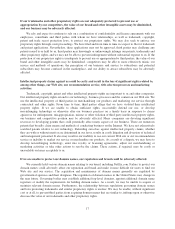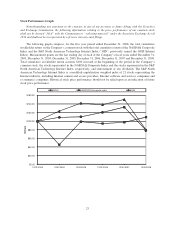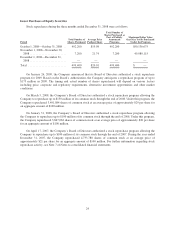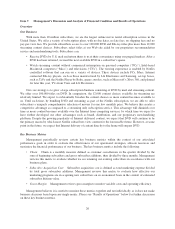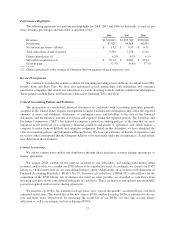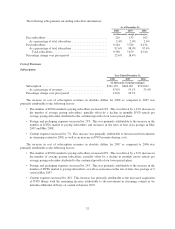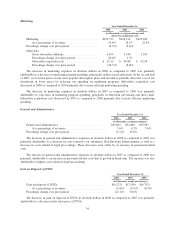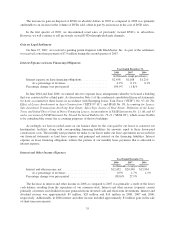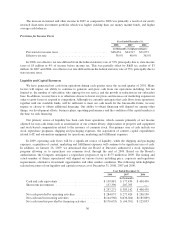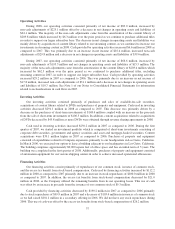NetFlix 2008 Annual Report Download - page 32
Download and view the complete annual report
Please find page 32 of the 2008 NetFlix annual report below. You can navigate through the pages in the report by either clicking on the pages listed below, or by using the keyword search tool below to find specific information within the annual report.
Performance Highlights
The following represents our performance highlights for 2008, 2007 and 2006 (in thousands, except for per
share amounts, percentages and subscriber acquisition costs):
2008 2007 2006
Revenues ........................................ $1,364,661 $1,205,340 $996,660
Net income ....................................... 83,026 66,608 48,839
Net income per share—diluted ........................ $ 1.32 $ 0.97 $ 0.71
Total subscribers at end of period ..................... 9,390 7,479 6,316
Churn (annualized) (1) .............................. 4.2% 4.3% 4.1%
Subscriber acquisition cost ........................... $ 29.12 $ 40.86 $ 42.94
Gross margin ..................................... 33.3% 34.8% 37.1%
(1) Churn (annualized) is the average of Churn for the four quarters of each respective year
Recent Developments
We continue to broaden the content available for streaming including recent additions of content from CBS,
Disney, Sony and Starz Play. We have also announced several partnerships with technology and consumer
electronics companies that enable our subscribers to watch streaming content without commercial interruption.
These partners include Roku, LG Electronics, Microsoft, Samsung, TiVo and Vizio.
Critical Accounting Policies and Estimates
The preparation of consolidated financial statements in conformity with accounting principles generally
accepted in the United States requires management to make estimates and assumptions that affect the reported
amounts of assets and liabilities, disclosures of contingent assets and liabilities at the date of the financial
statements, and the reported amounts of revenues and expenses during the reported periods. The Securities and
Exchange Commission (“SEC”) has defined a company’s critical accounting policies as the ones that are most
important to the portrayal of a company’s financial condition and results of operations, and which require a
company to make its most difficult and subjective judgments. Based on this definition, we have identified the
critical accounting policies and judgments addressed below. We base our estimates on historical experience and
on various other assumptions that the Company believes to be reasonable under the circumstances. Actual results
may differ from these estimates.
Content Accounting
We obtain content from studios and distributors through direct purchases, revenue sharing agreements or
license agreements.
We acquire DVD content for the purpose of rental to our subscribers and earning subscription rental
revenues, and, as such, we consider our DVD library to be a productive asset. Accordingly, we classify our DVD
library as a non-current asset on our consolidated balance sheets. Additionally, in accordance with Statement of
Financial Accounting Standards (“SFAS”) No. 95, Statement of Cash Flows, (“SFAS 95”) cash outflows for the
acquisition of the DVD library, net of changes in related accounts payable, are classified as cash flows from
investing activities on our consolidated statements of cash flows. This is inclusive of any upfront non-refundable
payments required under revenue sharing agreements.
We amortize our DVDs, less estimated salvage value, on a “sum-of-the-months” accelerated basis over their
estimated useful lives. The useful life of the new-release DVDs and back-catalog DVDs is estimated to be one
year and three years, respectively. In estimating the useful life of our DVDs, we take into account library
utilization as well as an estimate for lost or damaged DVDs.
27


